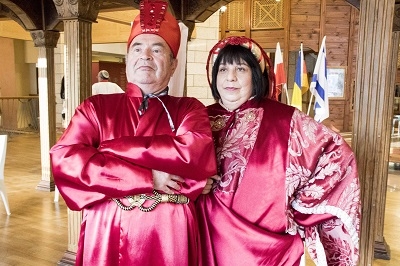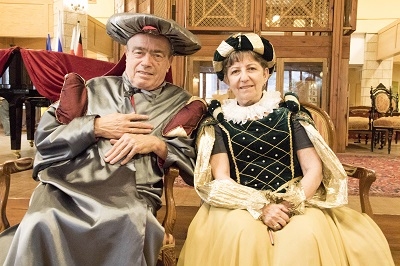Preserving the Deeds of a 16th Century Zionist
Norma and I joined the ESRA Dona Gracia trip, thanks to the good advice of our friends in Netanya. The full bus picked the six of us up on the coastal road in Netanya. We stopped for an important coffee break on the way to Kibbutz Kvutzat Kinneret. Our guide, Adina, told us vivid stories of historical happenings along the way. Then we made a visit to Naomi Shemer's parents' home and the Kinneret cemetery where so many famous personalities of our 20th century history are buried, including Naomi Shemer, of course.
We then moved to the date factory to hear about the start of the date industry here in modern Israel. Young palm trees were brought to Israel with the help of Jewish Iraqis, even though getting caught could have resulted in death by hanging. Afterwards, we gorged ourselves, tasting the many different types of dates, managing to do serious damage to their tasting supply and to our pockets when we lined up to pay!
After a short lunch (excellent ice cream for some of us– and such big portions) we arrived at The Dona Gracia House Hotel and museum in Tiberias at around 4pm. Dona Gracia – her real name Gracia Mendes Nasi (Hannah) a.k.a Beatrice de Luna 1510–1569 - was the daughter of a Jewish family who had fled Spain during the Inquisition.
We were welcomed with coffee and cake. We sat and chatted amidst the 16th century Sephardic Jewish atmosphere. After a short time, Irit Ashdoot, the museum director, invited us to hear about the life and feats of Dona Gracia. She related the story to us in different rooms, including a replica of a 16th century synagogue and a dining room in Dona Gracia's 16th century house.
Irit also explained how a failed mall had become the only hotel museum in the world. The central ideas of the Casa are fostering female leadership in human and Jewish history, expressing the central legacy of Ladino culture and the importance of Tiberias in the history of the Jewish people. Dona Gracia had dedicated her life and fortune to preserving her Jewish heritage and, with the blessing of the Turkish Sultan, had started a Jewish settlement in Tiberias for trade and learning. A 16th century Zionist! Much research is still underway into keeping this a unique living museum dedicated to preserving her name and deeds on behalf of the Jewish people alive. Google her - she had been a billionaire who had invited the poor for dinner every second night.
Many of us then dressed up in 16th century costumes to have our photos taken. After the superb museum supper, some of us chatted for hours and others went upstairs to watch a film.
After spending the night in a comfortable room (with boiling hot water in the showers!) we had breakfast, checked out and drove to Magdala on the Northern tip of the Kinneret. You can read about Magdala in a separate article ….
Back on the bus, we set off to visit the Yigal Alon Museum and a boat from biblical times which had been found in the Kinneret. Now on display in a special frame, its wood has been treated with special materials so that it can be viewed in a dry state.
On the way to lunch we reached the observation point at the Chera Observation Post, one of the most complicated projects ever attempted by Mekorot (1968), the national water carrier. The water from the Kinneret is raised to a height of 250 meters (tantamount to lifting the water in an elevator to a height of more than 80 floors) on the Eastern bank of Nahal Amud. This observation point overlooks the beautiful Nahal Amud scenery right down to the Kinneret. The water crosses the ravine (about 150 meters) and rises to the western side according to the law of physics of connected vessels.
The Mekorot spokesman could represent us internationally. He was funny, knowledgeable, fascinating and almost diplomatic. He told us that the water could - and used to - reach the Negev. Today we mainly use desalinated water. He told us that Jordanians only have running water a few days a week. We ate lunch at a restaurant on the banks of the Kinneret on our way home.
This trip was well-planned and exceptionally well organized. The driver was excellent+. Our guide, Adina, was passionately informative throughout the memorable trip. ESRA is to be commended for achieving such a high bar. This trip was very, very good.
In case you hate Google:
Gracia Mendes Nasi (Hannah) a.k.a, Beatrice de Luna (1510–1569) was a daughter of a Jewish family which had fled Spain during the Inquisition. She married Francisco Mendes/Benveniste. After her "Christian wedding" she was married again, to her astonishment, in the basement of a building, in a Jewish ceremony during which she had been told that she was Jewish. Once she knew that she was Jewish, she helped her husband run an escape network that saved hundreds of Conversos from the Inquisition. After her husband died she carried on the business, becoming one of the wealthiest women in Renaissance Europe.
She was the aunt and business partner of Joao Micas (Hebrew name, Joseph Nasi). Because of the Inquisition she was given sanctuary in Constantinople by the Sultan. At one time she managed 350 cargo ships that transported spices and textiles between Europe and the Far East. She was granted a long-term lease on the Tiberias region of the Galilee with the blessing of the Sultan, as he would not give her Jerusalem. She then tried to attract Jewish people to live in Tiberias to make it into a center for trade and learning. This venture has often been called one of the earliest attempts at a modern Zionist movement. Dona Gracia (Mendes) Nasi died in Istanbul in early 1569.












Comments